The
Artwork of
Henry E. Kidd
Fine Virginia Artist
& Author
September 11, 2001 & AdoptAStation
Art:
Confederate Medal of Honor
designed by Henry Kidd
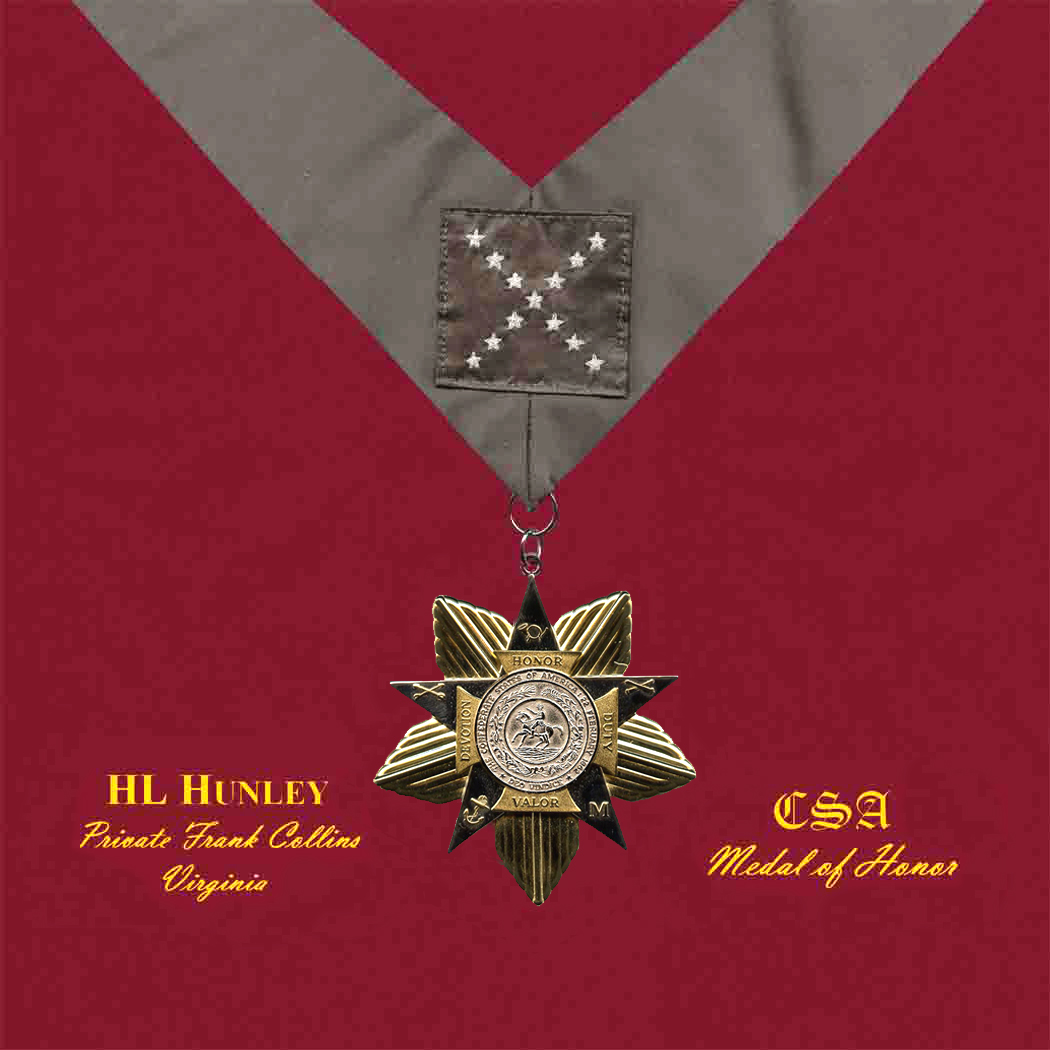
Confederate Medal of Honor and the
Hunley Presentation
A Confederate Medal of Honor was presented to each crewmember of the Confederate submarine, HL Hunley, in Charleston, SC on August 3, 2000, just days before it was raised from the bottom of Charleston harbor. The presenter of these medals was the highest decorated living veteran in America, Rear Admiral Eugene Fluckey. Having receiver four Navy Crosses and the Congressional Medal of Honor himself for his actions onboard the WWII submarine USS Barb, Admiral Fluckey was humbled to present the crew of the first submarine in history to sink an enemy vessel during time of war with their Confederate Medals of Honor.
The presentation of any Confederate Medals of Honor is the fruition of the Confederate Congress. On October 10, 1862, they passed an act to authorize the grant of medals and badges of distinction as a reward for courage and good conduct on the field of battle. It was then passed into law later that same day when President Jefferson Davis signed the act. With the turmoil of war, the medals were never struck or issued. In 1968, the SCV approved a resolution to re-establish the Confederate Medal of Honor and present them posthumously to the brave Confederate soldiers and sailors whose bravery and sacrifice deemed worthy of the recognition.
The first Confederate Medal of Honor that was designed in the 1970’s received much criticism because of its’ appearance. It did not match the stature of its name. The current Confederate Medal of Honor was redesigned by Past ANV and Virginia Division Commander, Henry Kidd. Here is how Commander Kidd describes the medal.
“Personally, I cannot express how humbled I am to have designed this Confederate Medal of Honor and have it presented to our Confederate ancestors. The medal is struck from silver and bronze with a gray neck ribbon. I gave much thought to designing this medal. The Great Seal of the Confederacy rest on top of the Confederate Cross of Honor. Inscribed on each end of the cross are the words Honor, Duty, Devotion, and Valor. The cross rest upon a single star that signifies each individual state of the Confederacy. Each branch of military service is represented on each point of the star. Behind all of this is a starburst, which signifies the important of the medal. The neck ribbon is gray silk with a square of the same material sewn onto the ribbon with thirteen stars embroidered in the shape of the St. Andrews Cross to represent the battle flag.”
The crew of the Hunley was the first to be presented with the newly designed Confederate Medal of Honor. They are numbered and Lt. Dixon received number one. At Commander Kidd’s recommendation to the Hunley Funeral Committee, the crew’s Medals of Honor were carried on pillows behind each casket in the funeral procession.
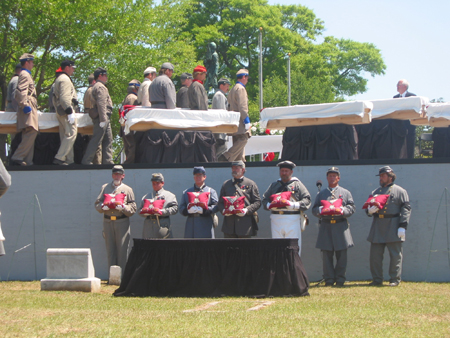
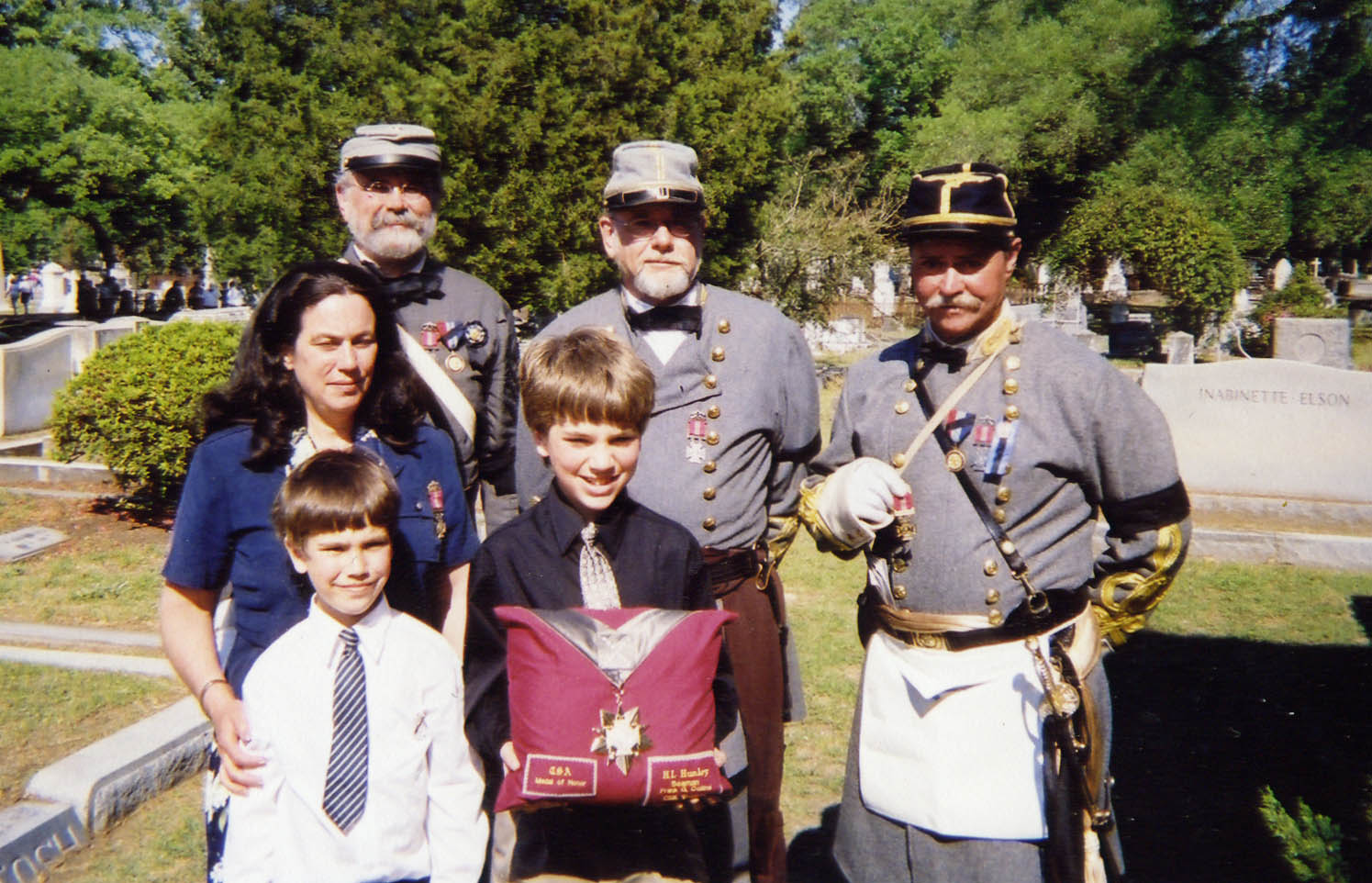
The Medal of Honor Honor Guard at the funeral. Descents of Frank Collins of the Hunley crew with Henry Kidd, back left, Sandy Lucas who led Lt. Dixon's riderless horse in the funeral and Randy Burbage, right, S.C.'s SCV Division Commander and the man in charge of the funeral.
The following article appeared in Confederate Veteran Magazine
Hunley Crew’s Final Honors
An insider’s view of the last week of preparations and honors for the Hunley crew
by Henry E. Kidd
We did it all for eight men. We did not do it for personal glory or gratification. We buried eight brave Confederate heroes. They were the last identified Confederate warriors to receive a proper burial. We know who they are and we know what they accomplished. Their deeds of valor and sacrifice will live forever. From Monday, April 12th to Saturday April 17th, 2004, they received the highest honors that we could bestow. With dignity, love and respect, we laid them to rest. Forever they will sleep beside the first two crews of the H.L. Hunley. To quote the Lt. Commander of the ANV and the Chairman of the Hunley Funeral Committee, Randy Burbage, “I know they are looking down on us and they must be thinking, God, they think a lot of us.”
What you will read in the next few pages is now a matter of history. I relate the events as how I witnessed and participated in them. I am humbled to have been a small part of the Hunley’s final tributes. I arrived in Charleston on Easter Sunday, April 11, 2004. Randy Burbage and his lovely wife Judy invited me to spend the week in their home. For the past four years, Randy had spent countless hours and days preparing every detail of the Hunley funeral. He had assembled a team of dedicated volunteers to assist him with the preparations and execution of this enormous task. I was just one of the volunteers.
Earlier, Virginia Division Commander Brag Bowling asked me to find men to serve as pallbearers and honor escorts for the only Virginian on the Hunley crew, Frank G. Collins. Randy Burbage had previously placed me in charge of the Confederate Medal of Honor bearers after I had recommended to the Hunley Funeral Committee that the medals, which were issued to the crew on August 4, 2000, should be carried on pillows behind each casket in the funeral procession.
On Monday morning, April 12th, I accompanied Randy to the Warren Lash Conservatory. We had a very important duty to perform. With all dignity possible, Randy Burbage, Mark Dangerfield, his son Zak, Louie Warmouth, Mike Squires and I commenced to seal the remains of the Hunley crew inside their coffins. The remains of each individual crewmember were already inside of locked copper boxes that measured approximately two by three feet and one foot deep. The boxes were marked with lettered codes to indicate who was inside. The following is a detail list of exactly what was done to prepare the each casket for burial. Affix identification name tags to the lid and the head end of the coffins; tap holes and screw the copper boxes to the bottom of the coffins; affix Hunley Honor Guard medals (serial numbered one thru eight) to the inside head of the coffin with two small brass nails; place the bottom and top halves of the lid on the coffin and glue the dowel pins into place; tap six countersunk holes to secure the lid to the coffin with screws; glue and plug each countersunk hole with a wooden dowel then cut the dowel to the surface of the coffin; finally, drape each coffin with a Second National Confederate Flag.
Maria Jacobsen, the archeologist who found Lt. Dixon’s gold coin, asked that we notify her before we sealed the coffins so she could come downstairs and pay her respects and say goodbye. This was an emotional moment for all of us. We were the crew’s surrogate family. The Hunley crew had never been more than a few feet away from their submarine in more than one hundred forty years. For the past four years their home had been the Warren Lash Conservatory. Although the crew had been silent, their absence would be sadly missed. Maria is a brilliant Danish woman who speaks seven languages fluently. She has no blood ties to the Hunley crew, but she grew to love, respect and admire them. She was obviously saddened as we closed the coffins.
I asked Maria how she felt when she found Dixon’s coin. She replied, “Even before I saw it, I knew what it was when it fell between my fingers. Every hair on my body stood up and my hands were trembling. It was if Dixon was speaking to us when I saw the inscription.” She said later that it would not be the same around here without them, that things would be different. After meeting Maria for the first time, I knew instantly that the crew had been in the care of loving hands.
Before Randy and I left the lab, we both placed our Dixon replica coins of his casket for a few minutes. Randy placed one coin and I placed two. We retrieved the coins before we left and placed them in our pockets. Later that evening, I took the coins out of my pocket and was shocked to find that one of them had dramatically tarnished in just a few hours. I can not explain it.
On Monday afternoon, Randy and I arrived at Patriot’s Point to await the arrival of the Hunley crew. At 5 o’clock, eight identical black hearses drove slowly down the long pier leading to the WWII aircraft carrier, USS Yorktown. Eight sets of Confederate pallbearers stood at attention as the hearses pulled into position. When they stopped and the back of hearse was opened, the pallbearers simultaneously marched into place behind each hearse. The decks and the stairs were crowded with mourners waiting to pay their respects. Members of the Hunley Commission, including South Carolina Senator Glenn McConnell and Randy Burbage waited on the dock underneath six flags flying at half-mast. The flags represented the states and the nation for which the Hunley crew had fought and died. They consisted of the Alabama, Maryland, North Carolina, South Carolina, Virginia and Second National Confederate flags. In a military funeral step, the pallbearers carried the caskets up the long stairs and onto the hanger deck of the USS Yorktown.
It was fitting that on their way to the Yorktown, the Hunley crew passed a modern submarine moored at the dock. As I watched the crew carried onto the Yorktown, I wondered how many sons, grandsons and great-grandsons of Confederate soldiers and sailors had died, fought, and served onboard this massive ship. It may even be possible that a descendent of one of the Hunley crew had served onboard this battle scared vessel.
The flag draped coffins laid side by side in front of a large black drape. Funeral director Mike Squires made sure that everything was perfectly in place. Everywhere the Hunley crew laid in state that week, Mike was there to care for them. One at a time, I handed Mike the Confederate Medals of Honor and he placed them at the foot of each black draped funeral bier (a stand for a casket). Honor Guards were posted and they stood motionless at attention. Next the members of the Hunley Commission signed the funeral visitation book and the mourners were invited in to pay their respects. After signing the funeral visitation books, they filed quietly by the caskets. Every fifteen minutes, the Honor Guards were ceremoniously changed. They presented arms and a ship’s bell was rung eight times. Thousands of people visited the Hunley crew onboard the Yorktown. At the close of the evening, all of the uniformed pallbearers and Honor Guards sang Dixie for the men of the Hunley.
On Tuesday, an old friend of Randy’s retired Colonel Jim Speichers arrived from Kansas City to also stay at the home of Randy and Judy. Jim is a member of the SCV and a reenactor and had started a reenacting club at the Citadel when he worked there. I mention Jim here because he and I were Randy’s extra pair of hands that week. I can not begin to tell you how many minute last details that Randy had to attend to before the funeral. It also seemed that everyone had questions for Randy besides all the reporters who wanted to speak to him. I am honored that Jim and I were able to help with many of the final details.
On Tuesday, the crew laid in state all day with honor guards constantly watching over them. That evening, in the ship’s theater the first memorial service of the week was held and the crew was serenaded by the Charleston Men’s Choir. Once again at the end of the evening, the honor guards sang Dixie to the crew. It is only fitting that I recognize the man who was in charge of the honor details Mark Dangerfield. Mark and the other volunteers did an outstanding job and I would like to thank them all. I was honored to take my turn under their command and stand my tour of duty as one of the Honor Guards.
On Wednesday the Hunley crew laid in state in a large hall at John Wesley United Methodist Church. That evening, they were moved into the sanctuary for their first of three church memorial services. I was moved by the pastor’s remarks that evening. She talked about the crew’s family. She said, “Their mother’s and their wife’s tears have long since dried away. They had no comfort of a graveside to visit and morn. There was no closure for the family and the sweethearts who loved these men. So, we will take the place of their families and morn for them.” Randy Burbage read the names of the crew while an Honor Guard member and I rang a ship’s bell.
I witnessed many acts of Southern hospitality while in Charleston. Everyone knew what it meant to other volunteers to be part of the Hunley funeral. I saw no acts of selfishness, only kindness and giving. Men went out of their way to make sure that everyone who wanted to participate had their chance. One particular act of kindness occurred at John Wesley United Methodist Church. The Hunley Commission struck a very special Honor Guard Medal that was only issued to the people who served as Honor Guard for the crew while they were at the Warren Lash Conservatory. Some people traveled great distances to stand at attention over the coffins of the Hunley crew. A descendent of Joseph Ridgaway arrived at the church in uniform and asked to serve as an Honor Guard. After serving his duty, another Honor Guard, Mr. Presley, unpinned his medal and presented it to Ridgaway’s descendent. I will never forget this unselfish act of giving.
The Hunley crew moved to the Cathedral of St. John the Baptist to lie in state on Thursday. Once again Jim and I served as Honor Guards. At 2 pm the first of three rehearsals for the pallbearers and honor escorts started at Magnolia Cemetery. Randy Burbage addressed the men who had assembled from all over the South. “I want to thank each of you for coming today. We have a lot of work ahead of us. But we have to remember what all of this is for. We are doing this for eight men. This is not about you or me. It is about those eight men, the crew of the Hunley. I need you to be patient and don’t worry if things don’t exactly go right here today. We have a lot of details to work out. On Monday the Pallbearers rehearsed all day. They messed up and couldn’t keep in step. But when crunch time came and the caskets arrived with the crew of the Hunley, they preformed flawless. And I know that you will as well.” Next, Randy introduced Mark Dangerfield who was in command of both pallbearers and honor detail. Mark was also directly in command of Lt. Dixon’s pallbearers. Then Randy introduced the men in charge of each pallbearer crew. These men were known as drivers.
A six foot high platform had been constructed beside the Confederate monument in the cemetery. Rows of headstones marked the graves of eight hundred Confederates buried around the monument including those who had been recovered from underneath the stadium at the Citadel. Eight funeral biers awaited the arrival of the caskets. Time and time again, the pallbearers rehearsed carrying the caskets up the stairs and onto the proper bier. With so much attention to the pallbearers, I realized that no one had rehearsed the military escorts. Mark could not help because he had his hands full with Dixon’s pallbearers. I informed Randy of the minor problem and asked him if he would like me to drill the escorts. Randy and I discussed the escorts roll then I drilled the escorts until they were comfortable with their duties. The day ended with a moving memorial service at the Cathedral of St. John the Baptist. During the service, Randy Burbage once again read the names of the Hunley crew and I rang the ship’s bell after each name.
That evening at Randy’s home, he concentrated on some last minute details for the funeral procession. Jim and I were also discussing the funeral. After some serious thought, I looked at Jim and said, “You know, the crew of the Hunley started their last journey in unisons with the command on one man, Lt. Dixon. Those eight men started their final journey in life together. I believe that symbolically, they should start their final journey in death as they had done in life. All the pallbearers need to lift their caskets simultaneously and start their final journey together by the orders of one man. I believe that that one man to represent Lt. Dixon should be Randy. He has done more work in preparation for this funeral than anyone. If anyone deserves this honor, it is Randy.” Jim agreed wholeheartedly with me. We waited for Randy to return to the living room and then we discussed the idea with him. He seemed to be honestly moved. The next day at the reversal I explained my idea to Mark Dangerfield and the other detail commanders. Everyone also wholeheartedly agreed.
Friday, the last day before the funeral was extremely busy. The Hunley crew was lying in state at the Church of the Holy Communion. The pallbearers, military escorts, Confederate Medal of Honor bearers, and the color guard had two practices that day, 9 am and 2 pm. With men coming from all over the Confederacy, there were some for one reason or another who did not show. Jim Spikers’ dream came through and he filled in for a missing pallbearer. Two entire military escort details were missing and Mark Dangerfield assured me that one of them was standing honor guard at the church and the other one would be there soon. Also half of another detail was missing and I replaced them with substitutes. Both rehearsals went well and we all felt confident that everything would go as planned on Saturday. I was still concerned that one military escort details had not shown for either practice.
We had done all we could do to prepare for the Hunley funeral. Jim and I attended the memorial service at the Church of the Holy Communion along with Randy, Judy, and their two lovely girls. This was the highest mass that an Episcopal Church can give. Everyone wanted to say farewell to these men in the most dignified way.
At 6 o’clock on Saturday morning, we arrived at the parking lot beside Magnolia Cemetery and caught a shuttle for White Point Gardens, otherwise known as the Battery. Here thousands of people assembled for the four and a half mile procession to Magnolia Cemetery. After I assembled all of the military escorts, I was dismayed that one detail was still not there. I was all set to go find reenactors to take their place when a lieutenant approached me and asked if we needed any help. I asked how many men he commanded and he said ten. That was exactly what I needed. I told him to stay put because I may in deed need him. I found Mark Dangerfield and informed him of the situation and told him that I had a good unit that could fill the void. He told me to do so. I do not know what detained this military detail, but the Lieutenant and his men were very grateful to have this honor. I assigned the officer in charge of Dixon’s escort to instruct the new men in their duties.
At 8 o’clock, the hearses arrived with the Hunley crew and submarine veterans served as pallbearers to place them on the funeral biers in front of the Confederate Monument. At 9:30, the final memorial service was held. Father James Parker and Randy Burbage spoke. It was at this moment I realized just how much of a part of Randy’s family, the men from the Hunley had become. Randy spoke as if these men were his brothers. He loved these eight men and he had done everything humanly possible to give these men the most dignified military funeral that one can give. I thought about these eight brave men and I knew that they represented not only the Hunley and the first two crews to perish, but they were the embodiment of the entire Confederacy. This was the funeral and these were the men that represented my great-grandfathers in the 13th North Carolina Infantry and the Virginia Artillery and every great-grandfather of everyone at the funeral with Confederate blood flowing in their veins.
The memorial service finished and eight horse drawn caissons from the 2nd Virginia Cavalry rumbled into position. The pallbearers marched to their places beside the caskets and awaited their orders. Commander Randy Burbage slowly gave the commands and the crew of the Confederate Submarine H. L. Hunley started their final journey in death as they had started their final journey in life. One man gave the orders each time to set them on their path with destiny.
Thousands upon thousands of people lined the funeral route. Many stood in silence with their hands over their hearts as the procession passed. The Hunley Commissioners lead the processional followed by the color guard and the Hunley crew. The pallbearers marched beside each caisson followed immediately by the pallbearer driver. Behind each driver was a single Confederate Medal of Honor bearer in front of the armed military escort. A rider less horse followed Lt. George Dixon’s casket. Behind the last caisson followed the nearly ten thousand people who marched the entire funeral route. They marched in the following order; Virginia Military Institute Band, reenactors, SCV, UDC, other organized groups and then civilians. It was nearly 1 o’clock when the head of the procession arrived at Magnolia Cemetery. Everyone was tired and footsore but we held our heads high in remembrance of the Hunley. The cemetery was packed with people awaiting our arrival. The police later told Randy that there were a lease one hundred thousand people in the cemetery. We marched down the lane and halted as each Hunley crewman was lovingly removed from the caisson and taken to the funeral biers waiting on the platform. One at a time the Medal of Honor bearers assembled in front of the platform. I was given the honor of carrying the Virginian’s Frank G. Collins medal in the funeral. When everyone was in position, the marchers were given a short break.
At 1:30, the funeral began. I was struck by the image of the Confederate reenactors massed among the rows of Confederate graves. They were tired, hot, hungry, thirsty, and footsore. They were the perfect image of the Confederate Army on the move. I also noticed something else about them. They held themselves with a sense of pride. They listened intently to every word of the funeral service. I was proud to be among such men who love their Confederate ancestors. When the minister prayed for the Hunley crew they removed their hats and prayed to God. I know the crew is already in Heaven, but I feel that we formally introducing them to St. Peter. The service ended and I marched the Medal of Honor detail out in front of the crowd to retrieve the medals where we had placed them on a funeral bier in front of the platform. Lt. George Dixon’s pallbearers brought his casket down from the platform to the lower bier for a Masonic Funeral Service. I marched the medal detail to the gravesite where we awaited the crew.
When the Masonic Service was over, the funeral procession continued to the rear of the cemetery to the gravesite. The first two crews who died serving onboard the Hunley were buried beside the open grave. Finally all three Hunley crews would be together. The family members of the crew walked past the grave and assembled close by. The Hunley Commissioners came next and stood across the narrow path from the grave. I formed the medal bearers behind the family then I took my place beside an Honor Guard holding a ships bell. We stood among the first and second Hunley crews, beside the open grave. Then the color guard led the pallbearers to within a few feet of the grave and then stepped aside. The flags on the caskets were folded and the Honor Guards presented them to each family and slowly saluted. Then the family members presented the flags to the Hunley Commission for safe keeping until they can be properly displayed in a museum yet to be built. Senator Glenn McConnell read the final roll of the Hunley crew and I rang the ships bell for each man one final time.
Lt. George E. Dixon, Seaman Arnold Becker, Crewman C. Simpkin, Seaman Frank G. Collins, Corporal J. F. Carlsen, Seaman Miller, Boatswain Mate James A. Wicks, Quartermaster Joseph F. Ridgaway.
My eyes moistened and a tear ran down my cheek. I watched Lt. Dixon and his crew descend into the grave. I thought of them in their tiny submarine descending, so many years ago, beneath the waves. I salute Lt. Dixon and his crew, may God bless them and keep them. They have completed their journey home.
Henry Kidd with the Llewellyn CSA Medal of Honor.
On June 3, 2009 Henry Kidd presented the Confederate Medal of Honor to Dr. David Herbert Llewellyn of the CSS Alabama at Marlborough College, eighty miles west of London, England. Dr. Llewellyn was a student of the college.
Confederate Medal of Honor
Citation
David Herbert Llewellyn, M.D.
Surgeon CSS Alabama, C.S.N.
Engagement with USS Kearsarge
Off The Coast of Cherbourg, France
19 JUNE 1864
“With the battle lost and the Alabamagoing down, Dr. Llewellyn, upon hearing the order to abandon ship, patiently assisted the wounded into a crowded lifeboat. Despite the entreaties of those he had helped, Dr. Llewellyn remained aboard the Alabama, refusing to board the lifeboat for fear of capsizing the already dangerously crowded vessel. When the great ship disappeared beneath the waves, Dr. Llewellyn was last seen alive jumping into the turbulent open sea, never once having mentioned that he could not swim.”
First International Confederate Medal of Honor
Presented to CSS Alabama’s Assistant Surgeon,
Dr. David Herbert Llewellyn
By Henry E. Kidd
Past Commander of the Army of Northern Virginia
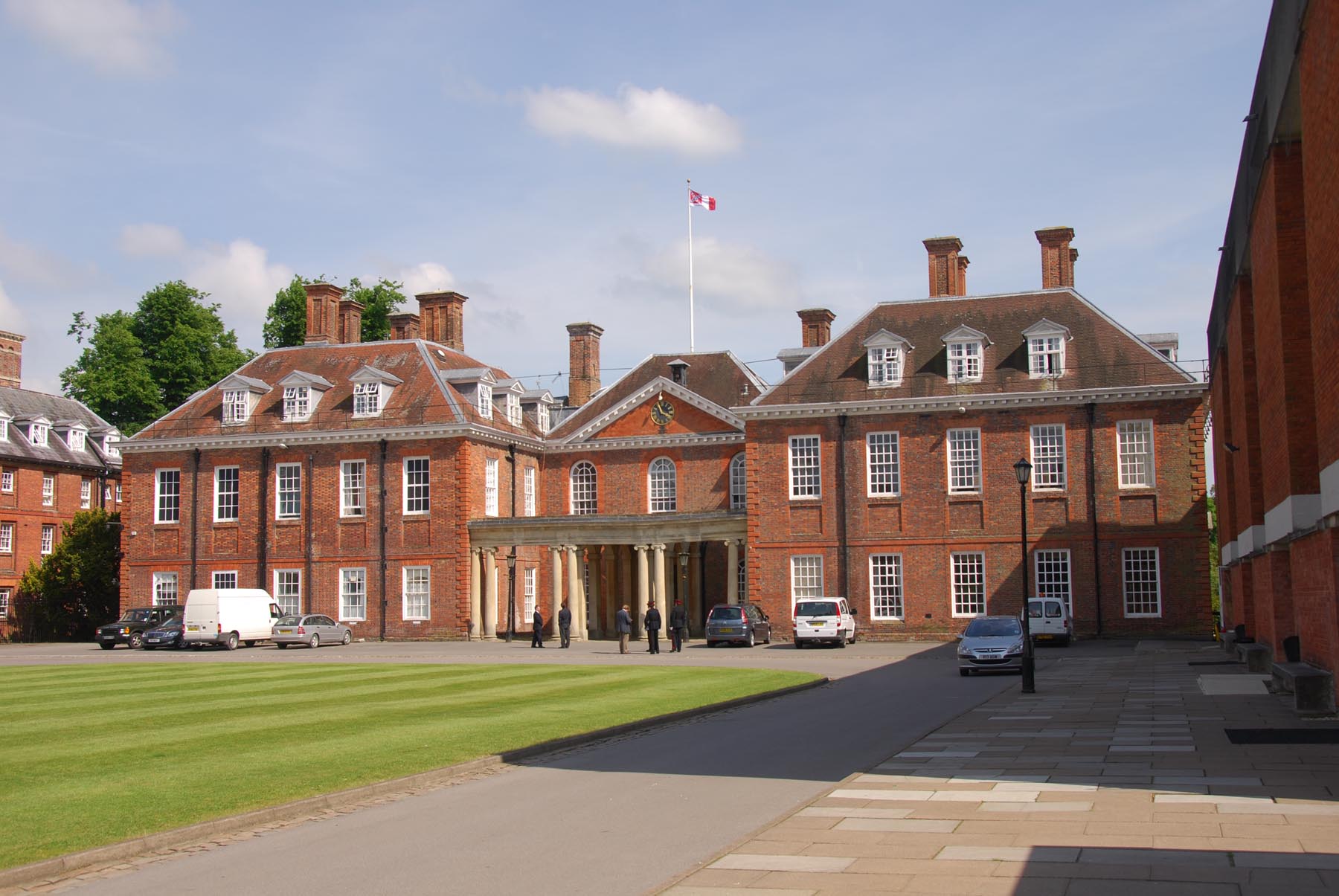
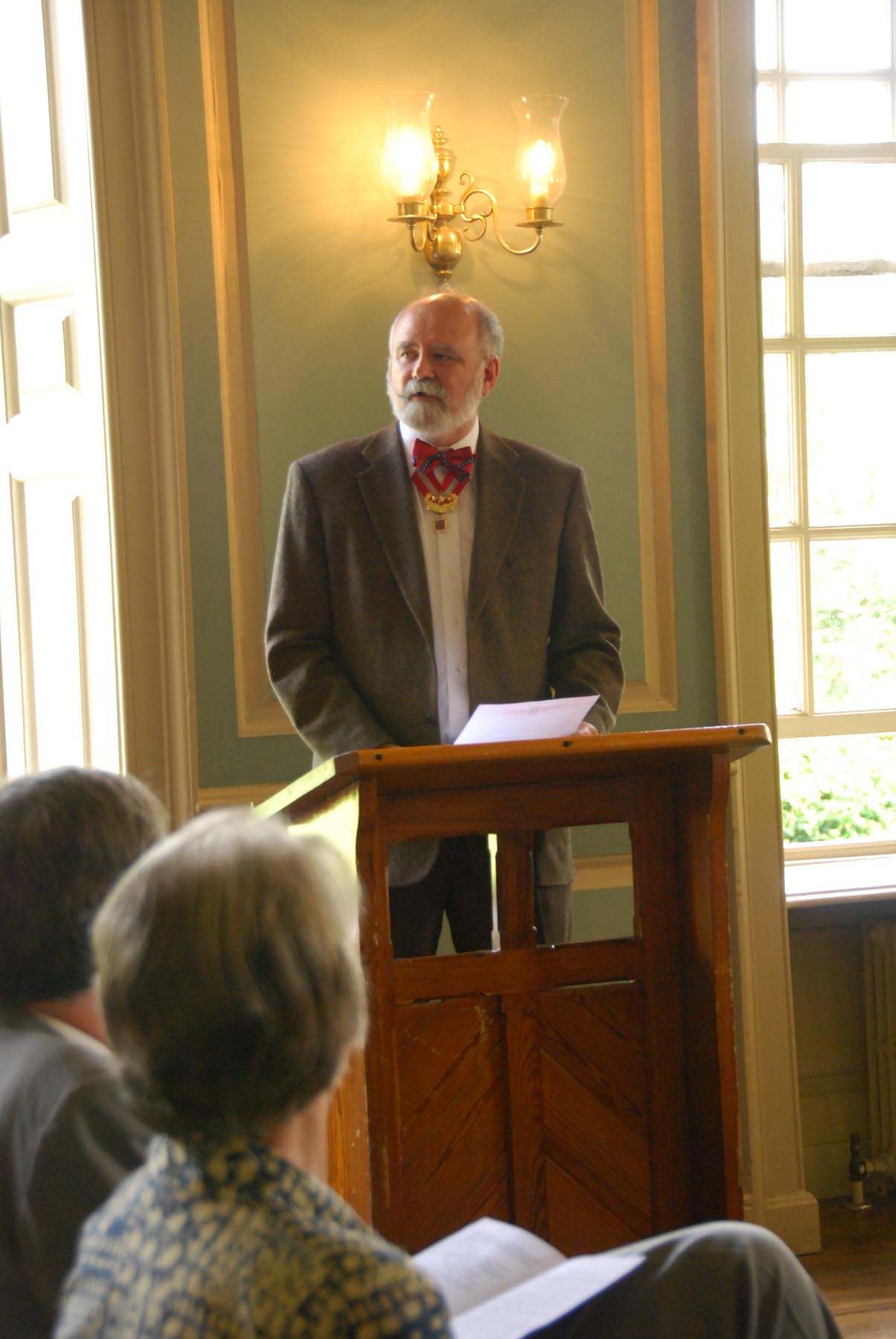
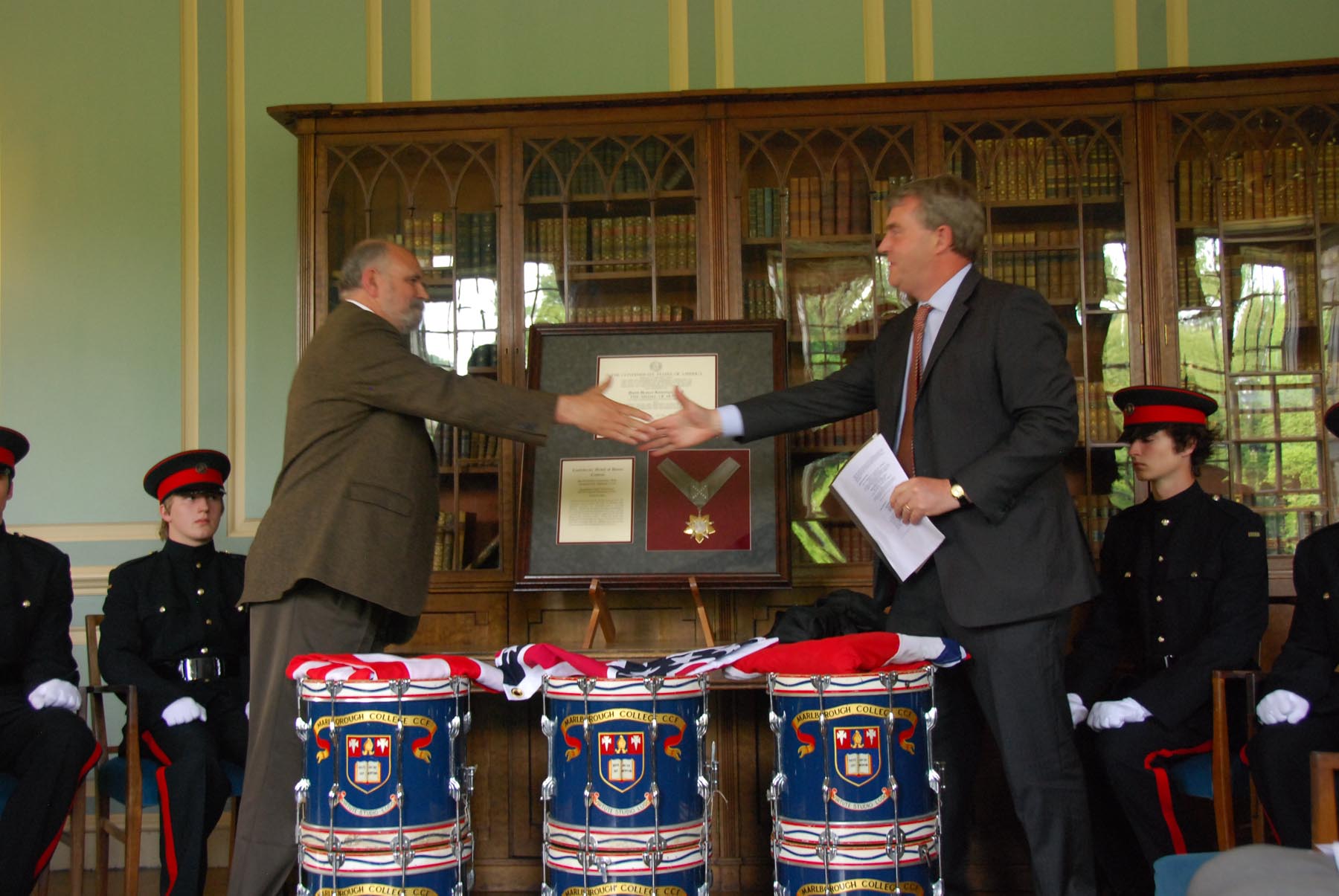
Marlboro College; Henry Kidd; and Henry Kidd presenting the Medal to Headmaster Sampson
The Third National Confederate Flag flew high above the main building of Marlborough College, in Marlborough, England, on June 3, 2009 in honor and memory of British citizen and former student, Dr. David Herbert Llewellyn. Inside its halls, a distinguished group of students, guest, and professors, including the Headmaster of the College, Dr. Sampson, gathered for a unique presentation to the College. All stood as the Royal Corps of Cadets trooped in the colors of three nations, Great Britain, United States, and the Second National Flag of the Confederate States of America. Next, the national anthems were played including Dixie. What followed was an eye-opening, historical presentation to that won the respect of everyone in attendance.
It needs to be said that this ceremony was arranged totally by members of the college, who have no affiliation with the SCV or any Confederate historical group at all. This is why I am proud to say that in all my years in the SCV, I have never attended a more distinguished ceremony to honor a Confederate hero that was not under the control of the SCV or UDC. To see our flag flying so proudly from the main building and to hear Dixie played so beautifully was a very moving moment. Political correctness never reared its’ ugly head once.
Dr. Llewellyn’s and the Alabama’s story;
Dr. Llewellyn was one of the first British citizens to join the cause of the Confederacy. In July of 1862, when the Alabama (then known as the Enrica) left Liverpool, Dr. Llewellyn was on board. Union agents had attempted to get British authorities to stop the Enrica from leaving. They knew this ship was built for the Confederacy. Since the British had no ties with the Confederacy, their laws forbid the building of warships for the CSA. However, many British authorities sympathized with the Confederacy and found reasons to delay. This allowed the Enrica to leave under the pretext of a shakedown cruise with ladies and musicians on board.
The Enrica sailed for the Azores after transferring the ladies to another ship for their return to Liverpool. There they met Capt. Raphael Semmes who oversaw the refitting of the vessel with various provisions, armaments, and 350 tons of coal, brought by Agrippina. The British-made ordinance composed of six broadside, 32-pounder, naval smoothbores and two more powerful pivot cannons. The pivot cannons were positioned amidships along the deck's centerline, fore and aft of the main mast. The fore pivot was a long-range 100-pounder 7-inch Blakely rifle, the aft pivot an 8-inch smoothbore.
On August 24, 1862, the ship was re-commissioned the CSS Alabama. Capt. Semmes made a brief speech on the quarter deck and convinced more than eighty of the British crewmen to join in the cause of Southern Independence. For the next two years, the CSS Alabama captured, burned, and sank sixty-five Union ships. To Northern sailors and merchants, the Alabama quickly became the terror of the high seas. They begged the US government to do something about the Alabama.
In the South, Capt. Semmes and the Alabama crew became heroes. With so much bad news on the home front, it was very welcome news to read the exploits of the Alabama. Contrary to the reports in northern newspapers, the Alabama fought a gentleman’s war. Of the sixty-five Union ships captured or sunk, not one death was recorded. The crews were transferred to the Alabama until they could be transferred to a neutral vessel or port.
Near the end of the two years, the Alabama was in dire need of repair. Her boiler needed an overhaul; much of her powder and shells were wet; the rigging needed to be refitted and most important was her copper plated hull was coming apart. Many strips of copper had pealed back, causing drag in the water that drastically slowed her speed. Capt. Semmes decided to set sail for a neutral port for repairs. On June 11, 1864, the Alabama arrived in Cherbourg, France.
USS Kearsarge, fresh from refitting and overhaul, was looking for the Alabama near the Netherland coast. A northern agent in Cherbourg manager to get word to the Kearsarge that the Alabama was in port. Three days later, she arrived. The Alabama was inside France territorial waters as the Kearsarge slowly steamed past. The two crews took a long look at one another. One can only imagine what was in the minds of the men as the ships passed. The Kearsarge posted herself just outside the harbor.
Capt. Semmes was now left with three choices; he could have the Alabama repaired and give time for more Union warships to arrive; he could try and slip out of the harbor at night and avoid a fight; or he could do battle. Semmes chose the latter. Through diplomatic channels, Semmes sent a challenge to the Kearsarge's commander, "My intention is to fight the Kearsarge as soon as I can make the necessary arrangements. I hope these will not detain me more than until tomorrow or the morrow morning at farthest. I beg she will not depart until I am ready to go out. I have the honor to be your obedient servant, R. Semmes, Captain."
Semmes prepared his ship and drilled the crew for the coming battle during the next few days. Dr. Llewellyn wrote his final letter to Mr. Travers, the resident medical officer of Caring Cross Hospital, "Cherbourg, June 14, 1864. Dear Travers, …Here we are. I send this by gentleman coming to London. An enemy is outside. If she only stays long enough, we go out and fight her. If I live, expect to see me in London shortly. If I die, give my best love to all who know me. If M. A. de Caillet should call on you, please show him every attention. I remain, dear Travers, ever yours, D. H. Llewellyn."
On June 19, the Alabama steamed out to do battle with the Kearsarge. The two warships circled each other in an ever tightening circle. After several exchanges of gunfire, the Alabama struck the first critical blow. The Alabama’s forward seven-inch Blakely pivot rifle, hit the Kearsarge 's vulnerable sternpost. The impact would have disabled the Kearsarge’s rudder but shell failed to explode. The Kearsarge had two other advantages along with its’ recent overhaul. Her two pivot guns were powerful 11-inch Dahlgrens, larger than any on the Alabama, and portions of her hull were covered with iron chains, making her an ironclad.
After a little more than an hour, the Alabama began sinking. Capt. Semmes sent his first officer below decks to access the damage. He returned and said that the ship had only ten minutes of life. Semmes ordered the colors struck and gave the order to abandon ship. All the while Dr. Llewellyn tended to the wounded on the blood soaked the slippery decks.
As the Alabama sank, Dr. Llewellyn helped the wounded into the two surviving, overcrowded lifeboats. The life boats were so packed with wounded men that Llewellyn feared that they would capsize with any additional weight. He held back one able-bodied sailor from climbing onboard and said, "See, I want to save my life as much as you do; but let the wounded men be saved first." Then an officer and friend in one lifeboat shouted to Llewellyn, "Doctor, we can make room for you." Llewellyn’s only response was, "I will not peril the wounded men."
All around Llewellyn, men jumped into the water and swam for safety. The doctor moved to the bow as the ship sank by the stern. The sailors in the lifeboats pulled hard at the ores to move away from the sinking ship. As the great ship, Alabama, sank below the waves, Dr Llewellyn was last seen jumping into the turbulent waters and drowned. His tragic death was made even worse when it was discovered that the doctor could not swim. Dr. Llewellyn never mentioned this fact. He knew his fate and gave up his life so he would not endanger the wounded.
Confederate Medal of Honor Ceremony;
After greetings from Headmaster Sampson, David DuCroz, past Head of History at the College, told the gathering the story of the Alabama. When Mr. DuCroz had finished, I rose to not only speak of Dr. Llewellyn’s bravery and sacrifice, but to give an overall history of the medal and a few of its’ past recipients. I told the tragic and heroic stories of our ancestors, from Sam Davis, the boy who was hung and never betrayed his friends to the Gallant Pelham at Fredericksburg, who held up an entire Union Division with only two cannons, to Sgt. Kirkland, who risk his own life to bring water and comfort to wounded Union soldiers and finally the noble story of the Hunley. The ceremony concluded with the unveiling of the medal by myself and Headmaster Sampson.
After the ceremony, I was driven to a nearby 15th Century Church where Dr. Llewellyn’s father had been the Reverend. Inside was a wonderful surprise. To the right of the alter was a magnificent memorial to Dr. Llewellyn’s service and sacrifice onboard the Alabama. Inscribed in marble are the words, ‘The east window and this tablet are dedicated to the memory of David Herbert Llewellyn, youngest son of the Rev. David Llewellyn, Minister of the Parish. He was the surgeon of the Confederate War-Steamer, “Alabama”. And after her engagement with the Federal steamer, “Kearsarge,” off Cherbourg, nobly refusing to imperil the escape of the wounded, he sank with the ship, on the 19th of June, 1864, in the 26th year of his age. Erected by voluntary contribution, in admiration of his sacrificing courage.’
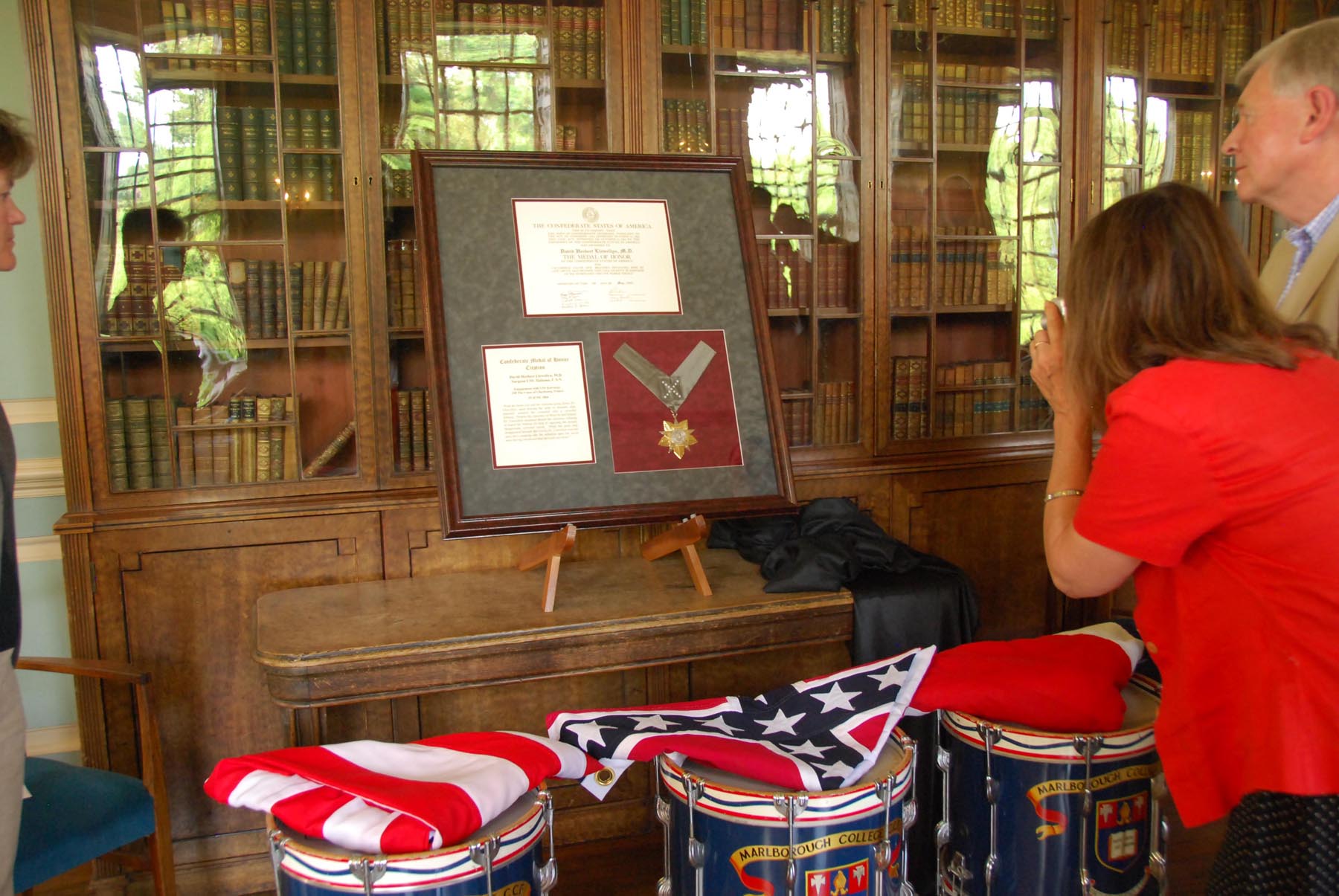
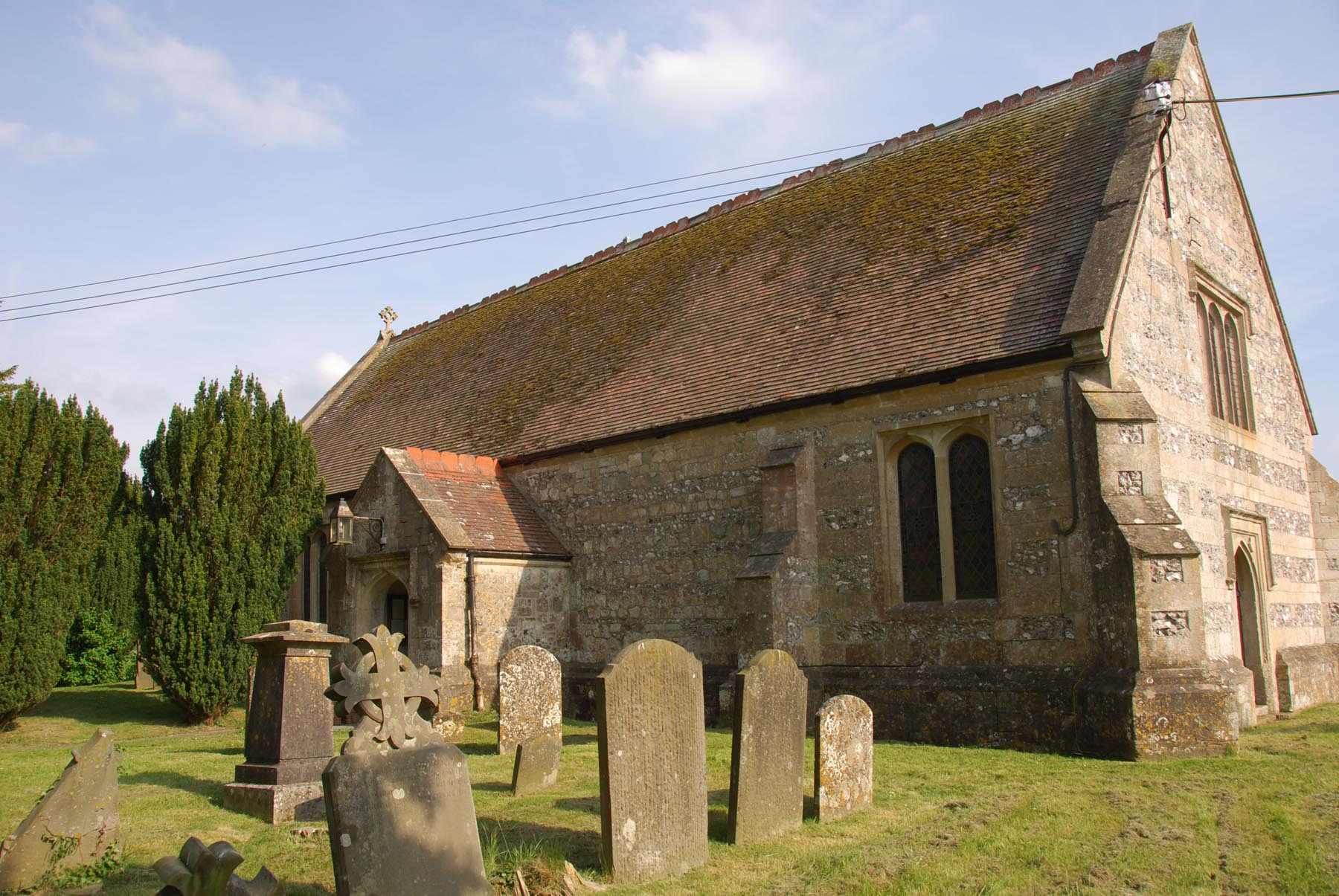
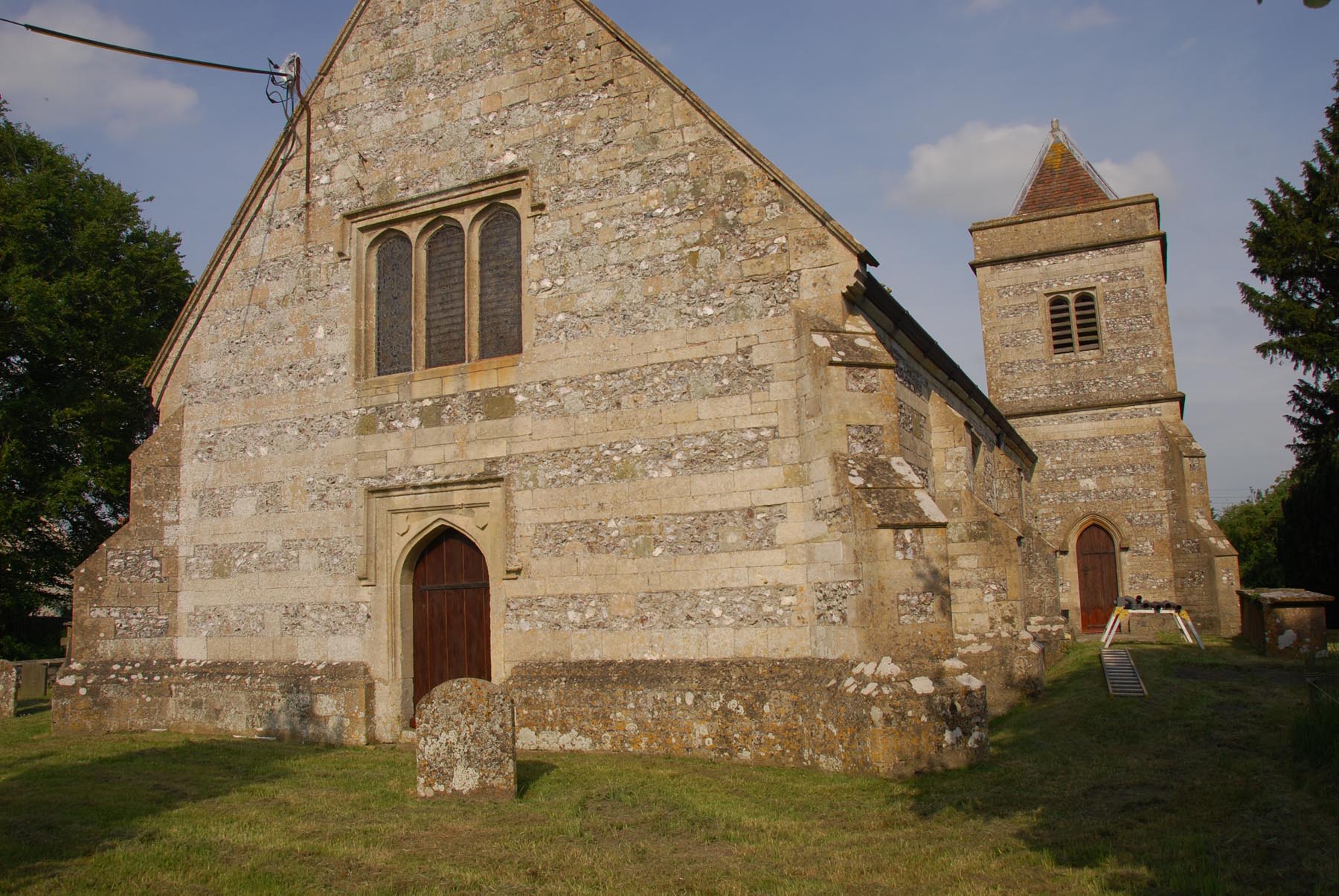
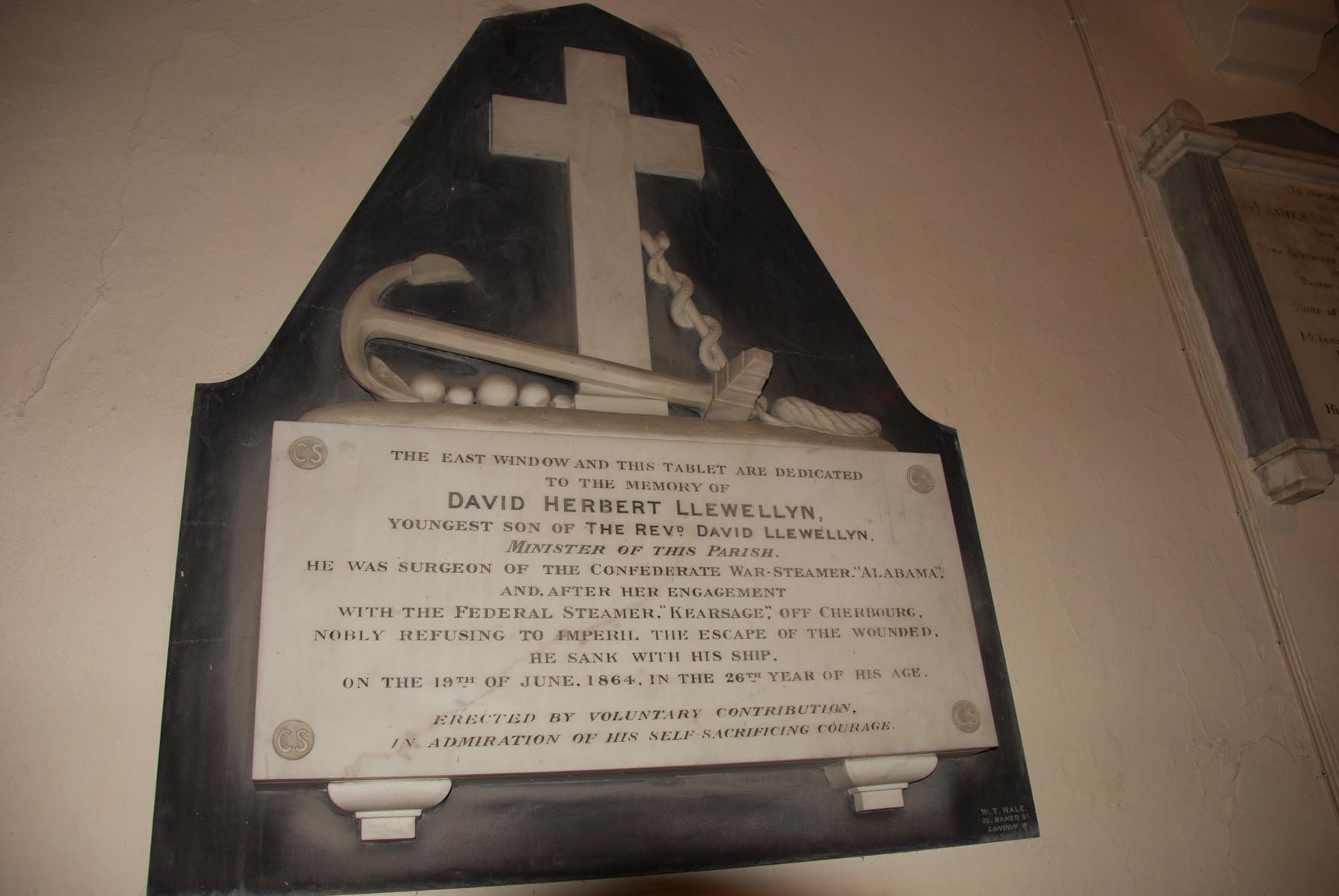
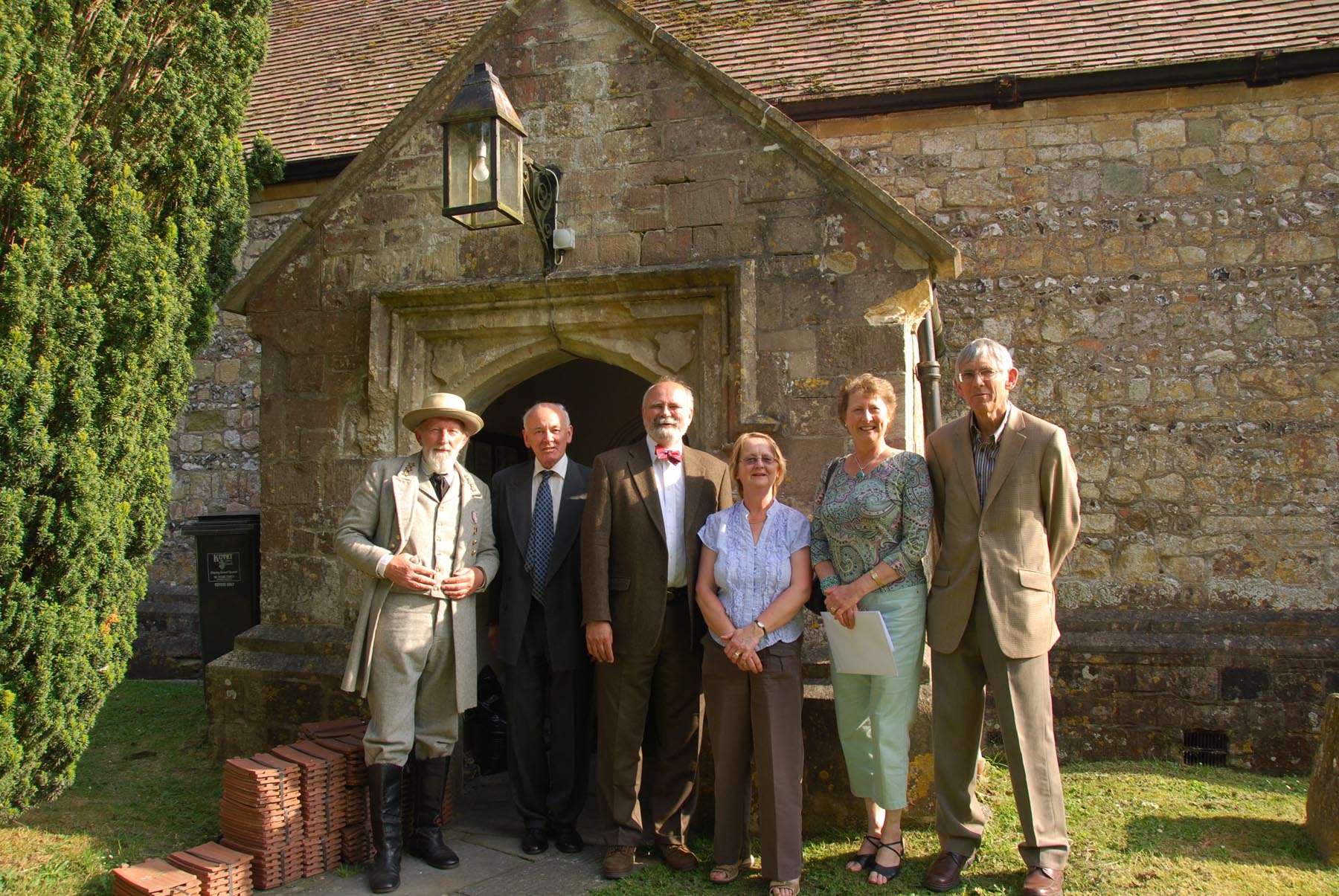
A formal dinner, hosted by Headmaster Sampson, ended the evening and the day’s tribute to Dr. Llewellyn. At the close of dinner, Dr. Terry Rogers, the former Archivist of Marlborough College and the man who planned most of the ceremony, stood and thanked all who attended and myself for coming to England to honor Llewellyn. He also announced that after my visit, the College would no longer teach Civil War history, from now on, we will teach the history of the War of Northern Aggression.